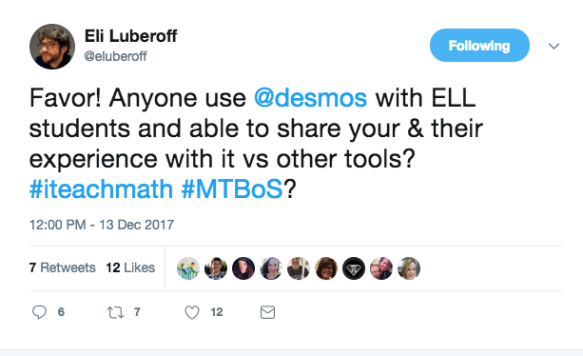Earlier this week Eli Luberoff, Founder and CEO of Desmos, Tweeted to inquire how various Tech. Tools are used to support English Language Learners:
Although I’m not working directly with English Language Learners, I spent nearly the first decade of my career as a Spanish bilingual elementary school teacher and try to bring that lens to much of the professional development work I currently do. While I had a lot I wanted to discuss around technology integration and supporting English Language Learners, I was at work when I read Eli’s post and threw out something quick:

As soon as I hit Tweet, I regretted it. Such a stock, somewhat thoughtless answer to someone who I knew was looking for more nuanced reflections. Yes, both those tools are helpful, but successfully using any tool to scaffold and support the learning of English Language learners is far more complicated than this.

Fast forward a week: Monday, first day of winter break. I take my 8-year-old son to my favorite homemade doughnut and coffee spot to hang out and play with one of my favorite weekend books: Anna Weltman’s This is Not A Math Book. (@annaweltman)
As we always do, I let him peruse the pages until he finds a set of imagery that appeals to him. He chose this page and we spent the next while doodling. We started on the same paper, taking turns building a drawing together, almost like a game of dots, but with doodles instead of closing boxes and gathering points. He then grabbed his own paper, incorporating these mathematical sketches into his own artwork.
And then I had an ah-had moment. We were doodling from Anna’s book, however THERE IS A DESMOS ACTIVITY which connects these doodles to formal, mathematical language:

Heck. There, in the center of Desmos’ introductory icon is the pinwheel my son had so gleefully turned into a flag in the hand of his creature. It was a reminder of the power of informal before formal. Language, reasoning, analysis…when first given opportunities for informal use, students are far more able to delve deeper into its formal use. And while this pedagogical principle is a part of all good mathematical teaching, it’s especially important for English Language Learners and other students who may initially have difficulty accessing the more formal, vocabulary-rich language of mathematics.
So thank-you Anna for mathematical fodder during a lovely morning of doughnuts and coffee and for helping me move beyond my stock response about how Desmos can be a powerful tool for supporting the learning of English Language Learners.






Bravo! Creative and thoughtful and with humility.
Mon, Dec 18, 2017
I love this. Maybe our boys will meet someday and figure out they have the commonality of mothers who bring them to coffee shops to play math games! Thank you for a new “math book” idea, too!
Excellent idea! As a selective school teacher I also try to find math games for my students, I have found that they help them learn perform better in exams because they learn better whilst having fun. I think this is how maths geniuses are created!